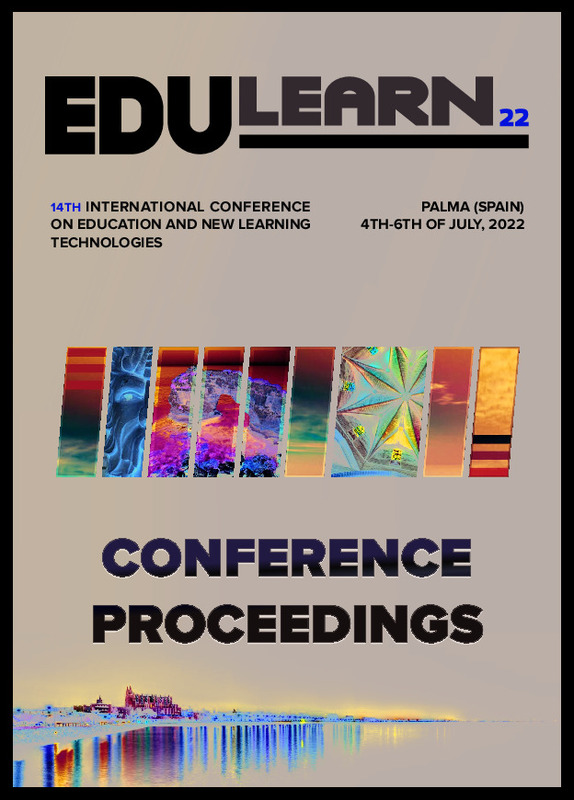JavaScript is disabled for your browser. Some features of this site may not work without it.
Buscar en RiuNet
Listar
Mi cuenta
Estadísticas
Ayuda RiuNet
Admin. UPV
Flipped learning and student approach to learning in a first year chemistry subject
Mostrar el registro sencillo del ítem
Ficheros en el ítem
| dc.contributor.author | Atarés Huerta, Lorena María
|
es_ES |
| dc.contributor.author | Leiva-Brondo, Miguel
|
es_ES |
| dc.date.accessioned | 2023-01-13T07:22:04Z | |
| dc.date.available | 2023-01-13T07:22:04Z | |
| dc.date.issued | 2022-07-06 | es_ES |
| dc.identifier.isbn | 978-84-09-42484-9 | es_ES |
| dc.identifier.uri | http://hdl.handle.net/10251/191296 | |
| dc.description.abstract | [EN] Flipped learning methodology transfers instruction from group learning space to the individual learning space, transforming the classroom in an interactive learning environment where the teacher uses the previously generated knowledge and outcomes to apply concepts and engage the subject matter. Student¿s approach to learning is how the student faces subjects from his/her personal point of view. It can be classified in deep and surface approach, that differ in the aim of the student with an intrinsic motivation for learning in the first and a meet of the requirements of the subject in the second. The influence of flipped learning on the student¿s approach to learning in a first-year subject of food science technology degree was assessed using the R-SPW-2F questionnaire. The reliability of the questionnaire was strong for the main subscales, but weaker for the secondary scales, with high correlations between the main scales and their related subscales. The students showed a slightly higher deep approach than surface approach, with no differences between flipped and non-flipped methodology. Male students showed higher surface approach than females. The students maintained their approach to learning regardless of the methodology used. Combining both methodologies in a same subject seems not to affect the election of the student approach to learning, but improvements can be made to high deep approach to reach higher performance results. | es_ES |
| dc.description.sponsorship | The publication of this work has been funded by a project of Educational Improvement and Innovation awarded by the Vice Dean for Studies, Quality and Accreditation of the Universitat Politècnica de València (Spain). | es_ES |
| dc.language | Inglés | es_ES |
| dc.publisher | IATED | es_ES |
| dc.relation.ispartof | Proceedings 14th annual International Conference on Education and New Learning Technologies (EDULEARN22) | es_ES |
| dc.rights | Reserva de todos los derechos | es_ES |
| dc.subject | Flipped classroom | es_ES |
| dc.subject | R-SPQ-2F | es_ES |
| dc.subject | Motivation | es_ES |
| dc.subject | Teaching methodologies | es_ES |
| dc.subject.classification | TECNOLOGIA DE ALIMENTOS | es_ES |
| dc.subject.classification | GENETICA | es_ES |
| dc.title | Flipped learning and student approach to learning in a first year chemistry subject | es_ES |
| dc.type | Comunicación en congreso | es_ES |
| dc.type | Capítulo de libro | es_ES |
| dc.identifier.doi | 10.21125/edulearn.2022.0369 | es_ES |
| dc.rights.accessRights | Abierto | es_ES |
| dc.contributor.affiliation | Universitat Politècnica de València. Escuela Técnica Superior de Ingeniería Agronómica y del Medio Natural - Escola Tècnica Superior d'Enginyeria Agronòmica i del Medi Natural | es_ES |
| dc.description.bibliographicCitation | Atarés Huerta, LM.; Leiva-Brondo, M. (2022). Flipped learning and student approach to learning in a first year chemistry subject. IATED. 1410-1416. https://doi.org/10.21125/edulearn.2022.0369 | es_ES |
| dc.description.accrualMethod | S | es_ES |
| dc.relation.conferencename | 14th International Conference on Education and New Learning Technologies (EDULEARN 2022) | es_ES |
| dc.relation.conferencedate | Julio 04-06,2022 | es_ES |
| dc.relation.conferenceplace | Palma de Mallorca, Spain | es_ES |
| dc.relation.publisherversion | https://doi.org/10.21125/edulearn.2022.0369 | es_ES |
| dc.description.upvformatpinicio | 1410 | es_ES |
| dc.description.upvformatpfin | 1416 | es_ES |
| dc.type.version | info:eu-repo/semantics/publishedVersion | es_ES |
| dc.relation.pasarela | S\469327 | es_ES |
| dc.contributor.funder | Universitat Politècnica de València | es_ES |








